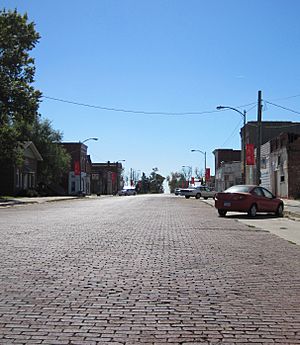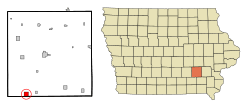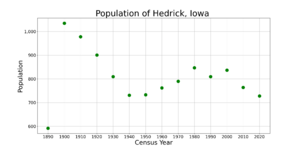Hedrick, Iowa facts for kids
Quick facts for kids
Hedrick, Iowa
|
|
|---|---|
 |
|
| Motto(s):
"Where Friends Meet"
|
|

Location of Hedrick, Iowa
|
|
| Country | |
| State | |
| County | Keokuk |
| Area | |
| • Total | 1.56 sq mi (4.03 km2) |
| • Land | 1.56 sq mi (4.03 km2) |
| • Water | 0.00 sq mi (0.00 km2) |
| Elevation | 820 ft (250 m) |
| Population
(2020)
|
|
| • Total | 728 |
| • Density | 467.27/sq mi (180.43/km2) |
| Time zone | UTC-6 (Central (CST)) |
| • Summer (DST) | UTC-5 (CDT) |
| ZIP code |
52563
|
| Area code(s) | 641 |
| FIPS code | 19-35670 |
| GNIS feature ID | 2394345 |
| Website | Hedrick, Iowa |
Hedrick is a small city located in Keokuk County, Iowa, in the United States. In 2020, about 728 people lived there.
Contents
History of Hedrick
Hedrick started as a town in 1882. This happened because two different railway companies, the Burlington and Western Railway and the Iowa Central Railway, built train tracks through the area. These tracks crossed the Rock Island tracks, making it a good spot for a train station and a new town.
The town of Hedrick officially became a city on April 23, 1883. It was named after a person called General Hedrick.
Over time, the railways changed. The Burlington and Western line, which was a "narrow gauge" (meaning its tracks were closer together), was made wider in 1902 to a "standard gauge." It then joined a bigger railway company. The Iowa Central also changed hands around the same time. However, the Burlington line was eventually closed in 1934.
By 1991, many shops on the main street of Hedrick had closed down. The local school also closed that year because it no longer met state requirements.
In 2023, a very strong tornado, rated EF-4, hit the city during a large storm.
Geography of Hedrick
Hedrick is located in Iowa. According to the United States Census Bureau, the city covers a total area of about 1.53 square miles (4.03 square kilometers). All of this area is land, with no large bodies of water inside the city limits.
Population and People
| Historical populations | ||
|---|---|---|
| Year | Pop. | ±% |
| 1890 | 592 | — |
| 1900 | 1,035 | +74.8% |
| 1910 | 978 | −5.5% |
| 1920 | 901 | −7.9% |
| 1930 | 810 | −10.1% |
| 1940 | 731 | −9.8% |
| 1950 | 733 | +0.3% |
| 1960 | 762 | +4.0% |
| 1970 | 790 | +3.7% |
| 1980 | 847 | +7.2% |
| 1990 | 810 | −4.4% |
| 2000 | 837 | +3.3% |
| 2010 | 764 | −8.7% |
| 2020 | 728 | −4.7% |
| Source: and Iowa Data Center Source: |
||
2020 Census Information
In 2020, a total of 728 people lived in Hedrick. There were 303 households, which are groups of people living together in one home. The city had about 467 people per square mile.
Most of the people living in Hedrick were White (96.2%). A small number were Black or African American (0.4%), Native American (0.1%), or from two or more races (3.3%). About 2.5% of the population identified as Hispanic or Latino.
About 26.1% of the households had children under 18 living with them. The average age of people in Hedrick was 39.8 years old. About 26.4% of the residents were under 20 years old. The population was almost evenly split between males (50.8%) and females (49.2%).
2010 Census Information
In 2010, there were 764 people living in Hedrick. There were 310 households and 211 families. The population density was about 499 people per square mile.
Most residents (98.3%) were White. About 1.2% were African American, and 0.5% were from two or more races. Hispanic or Latino people made up 1.4% of the population.
About 31.9% of households had children under 18. The average age in the city was 37.7 years. About 24.5% of residents were under 18 years old. The city had slightly more females (51.7%) than males (48.3%).
Economy
Today, not many businesses are open in the old part of Hedrick's main street. Most of the businesses that serve the public are now located along Highway 149.
Arts and Culture
Hedrick is known for its well-kept brick Main Street. It also has an old train station, called a depot. This depot used to serve two different railway lines: the Minneapolis and St. Louis Railway (which ran east-west) and the Chicago, Rock Island and Pacific Railroad (which ran north-south).
Notable Person
- Neal Edward Smith, a person who used to represent Iowa in the U.S. Congress.
Education
Hedrick is part of the Pekin Community School District. This school district runs schools in a nearby town called Pekin.
The old Hedrick Community School District was closed down by the state of Iowa on July 1, 1991. This happened because the school district did not meet the state's requirements to be a certified school. It was the first time a school district in Iowa was closed by the state government. Students who lived in Hedrick now go to schools in the Pekin district.
See also
 In Spanish: Hedrick (Iowa) para niños
In Spanish: Hedrick (Iowa) para niños


